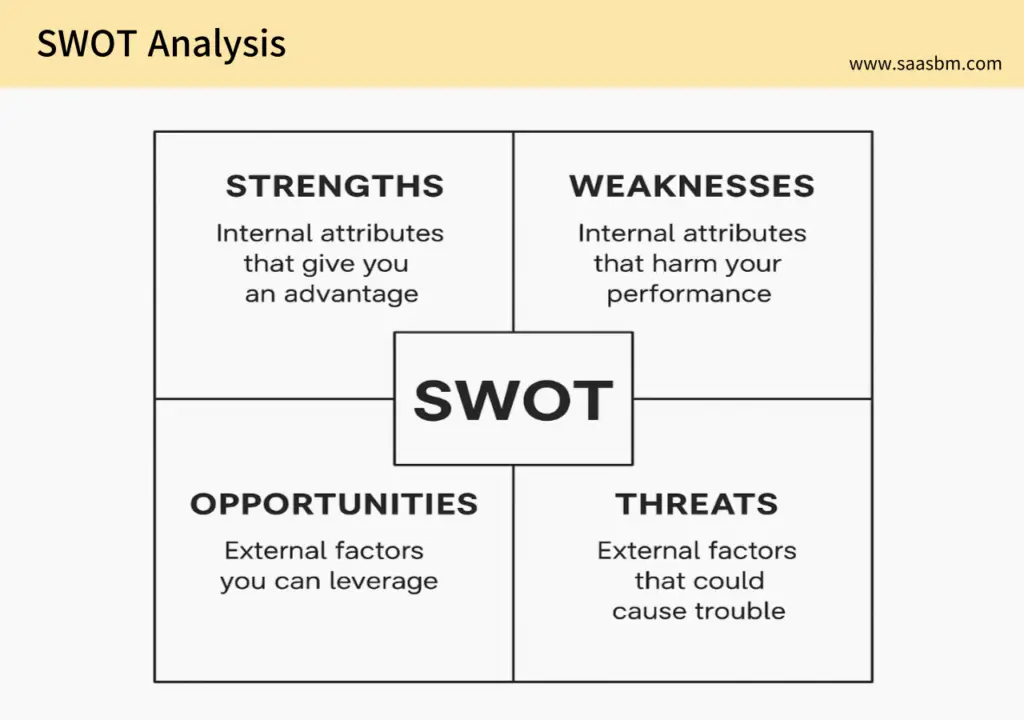Introduction
“Why aren’t users sticking around?”
“Are we ready to pitch to investors?”
“What’s our real edge over the competition?”
If you’ve ever asked yourself these questions, you’re not alone. Every early-stage SaaS founder faces them.
Before you scale, pivot, or raise funds, you need a clear understanding of where you stand — both inside and out.
That’s where SWOT Analysis comes in.
In this post, you’ll learn:
- What SWOT really means
- How to apply it to your SaaS business
- Key questions to ask
- A real SaaS example in action
- How to turn insights into strategy
Let’s dive in.
What Is SWOT Analysis?
SWOT stands for:
- Strengths – What you’re great at
- Weaknesses – Where you need improvement
- Opportunities – External trends or gaps you can leverage
- Threats – External risks that could harm your business
It’s a strategic tool to help you see your business from every angle.
And in SaaS — where recurring revenue and product-market fit are everything — a SWOT analysis is one of the fastest ways to map your path forward.
SaaS-Focused SWOT Breakdown
✅ Strengths
- Solving a specific pain point well
- Fast product development and agile team
- Recurring revenue through subscriptions
- Loyal early users giving rich feedback
Key Questions:
- What’s our core feature that competitors lack?
- Why do users choose us over others?
- Where can we execute faster than the competition?
⚠️ Weaknesses
- Low brand awareness
- Bugs, technical debt, or limited scalability
- Weak marketing funnel or sales process
- No strong analytics or data for decision-making
Key Questions:
- Why are users churning?
- Where is our UX failing?
- Are we ready for scale?

📈 Opportunities
- Accelerated digital transformation
- Growth in remote teams or niche verticals
- Integration/API partnerships
- Frustrated users of legacy tools
Key Questions:
- What trends are reshaping our space?
- What are our users unhappy about in other tools?
- Where are the market gaps?
🔥 Threats
- Enterprise players moving fast into our niche
- New SaaS tools launching daily
- Price-sensitive customers
- Funding winter or economic downturn
Key Questions:
- Are barriers to entry low in our market?
- Can we survive without raising capital soon?
- What external forces could pull users away?
Real-World Example: TimeHatch – A Scheduling SaaS for Creative Teams
Let’s say your startup, TimeHatch, offers a simple scheduling platform for design and video teams.
Here’s how SWOT might look:
| SWOT | TimeHatch Summary |
|---|---|
| Strengths | Clean UX, fast integrations, freemium model driving signups |
| Weaknesses | Limited analytics, weak CRM features, no enterprise play |
| Opportunities | Remote work trends, demand for Notion-like integration, untapped Asia market |
| Threats | Google Calendar bundling more features, churn at 7% monthly |
From this, you can derive actionable strategies:
- SO Strategy: Use strengths to seize opportunities → Deepen Notion integration to boost UX
- WO Strategy: Fix weaknesses to pursue opportunities → Improve CRM for Asian expansion
- ST Strategy: Use strengths to neutralize threats → Emphasize integrations to compete with bundled tools
- WT Strategy: Reduce weaknesses and threats → Trim features, focus on core experience
Summary: Why SWOT Matters for SaaS Startups
| Element | Strategic Purpose |
|---|---|
| Strengths | What gives you a competitive edge |
| Weaknesses | What limits your growth or scale |
| Opportunities | Where the market is moving |
| Threats | What could block or destroy progress |
Final Thoughts
SaaS isn’t just about building software — it’s about building value.
To deliver that value sustainably, you need to know your position in the market.
SWOT is simple, but it forces clarity.
It aligns your product roadmap, marketing strategy, and even fundraising pitch.
So before your next sprint or campaign, ask yourself:
“What are we great at, and what could take us down?”
The answers might change the way you build.

No comment yet, add your voice below!